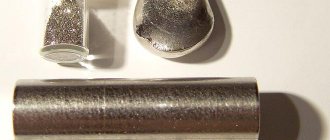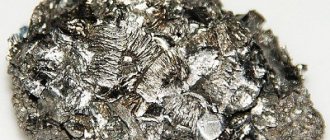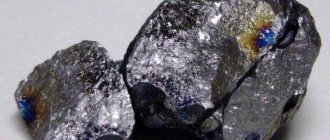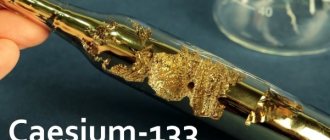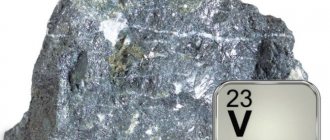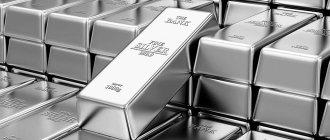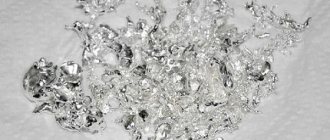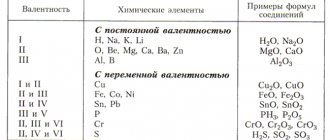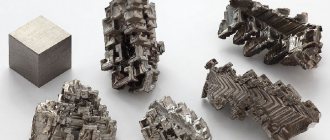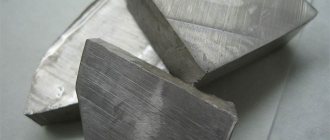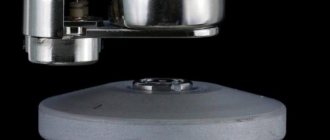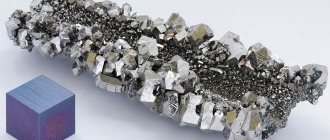Niobium, properties of the atom, chemical and physical properties.
Nb 41 Niobium
92.90638(2) 1s2 2s2 2p6 3s2 3p6 3d10 4s2 4p6 4d4 5s1
Niobium is an element of the periodic system of chemical elements of D.I. Mendeleev with atomic number 41. It is located in the 5th group (according to the old classification - a secondary subgroup of the fifth group), the fifth period of the periodic system.
Niobium atom and molecule. Niobium formula. Structure of the niobium atom
Isotopes and modifications of niobium
Properties of niobium (table): temperature, density, pressure, etc.
Physical properties of niobium
Chemical properties of niobium. Niobium interaction. Chemical reactions with niobium
Obtaining niobium
Applications of niobium
Table of chemical elements D.I. Mendeleev
Application
Ferroniobium is used in ferrous metallurgy for the production of microalloyed and stainless steels, as well as superalloys. Pure N. is used to produce heat-resistant and corrosion-resistant alloys with Zr for nuclear power (nuclear power plant fuel element shells contain about 7% Nb by weight) and aerospace. industry (gas turbine blades, parts of other structures), production of precision alloys for superconductors (magnetic coils). Niobium alloys with Ta, Ti, Mo, and others are used (see Niobium alloys). In the form of rolled products and wires, N. is used in the electronics industry (hot fittings, anodes, meshes, and other parts), in the form of a dispersed powder - in high-capacity electrolytics. capacitors, as an organic catalyst. reactions.
Pure Nb2O5 (with a content of at least 99.8%) is used to obtain optical fiber. materials, lithium niobate single crystals, high-temperature pigments. NbC carbide is used to make ceramics. heaters.
Niobium atom and molecule. Niobium formula. Structure of the niobium atom:
Niobium (lat. Niobium, in honor of the daughter of Tantalus Niobe) is a chemical element of the periodic system of chemical elements of D. I. Mendeleev with the designation Nb and atomic number 41. Located in the 5th group (according to the old classification - a side subgroup of the fifth group), the fifth period of the periodic table.
Niobium is a metal. Belongs to the group of transition metals.
The outdated name for niobium is columbium.
Niobium is designated by the symbol Nb.
As a simple substance , niobium under normal conditions is a shiny metal with a silvery-white color.
The niobium molecule is monatomic.
Chemical formula of niobium is Nb.
The electronic configuration of the niobium atom is 1s2 2s2 2p6 3s2 3p6 3d10 4s2 4p6 4d4 5s1. The ionization potential (first electron) of the niobium atom is 684.32 kJ/mol (7.09243(4) eV).
Structure of the niobium atom. The niobium atom consists of a positively charged nucleus (+41), around which 41 electrons move through five shells. In this case, 40 electrons are in the internal level, and 1 electron is in the external level. Since niobium is located in the fifth period, there are only five shells. First, the inner shell is represented by the s-orbital. The second - the inner shell is represented by s- and p-orbitals. The third and fourth - inner shells are represented by s-, p- and d-orbitals. The fifth - outer shell is represented by the s-orbital. At the internal energy level of the niobium atom, there are four unpaired electrons in the 4d orbital. At the outer energy level of the niobium atom, there is one unpaired electron in the s orbital. In turn, the nucleus of a niobium atom consists of 41 protons and 52 neutrons. Niobium belongs to the d-family elements.
The radius of the niobium atom (calculated) is 164 pm.
The atomic mass niobium atom is 92.90638(2) a. eat.
Niobium is chemically quite stable.
Niobium, properties of the atom, chemical and physical properties
Receipt
Niobium ores are usually complex and metal-poor. Ore concentrates contain Nb2O5
: pyrochlore - no less than 37%, loparite - 8%, columbite - 30-60%.
Most of them are processed by aluminum or silicothermal reduction into ferroniobium (40-60% Nb
) and ferrotantaloniobium. Metallic niobium is obtained from ore concentrates using complex technology in three stages:
1) opening of the concentrate, 2) separation of niobium and tantalum and obtaining their pure chemical compounds, 3) reduction and refining of metallic niobium and its alloys. Basic industrial methods for Nb
and alloys - aluminothermic, sodium-thermal, carbothermic: from a mixture of
Nb2O5
and soot, carbide is first obtained at 1800 in a hydrogen atmosphere, then metal is obtained from a mixture of carbide and pentoxide at 1800-1900 ° C in a vacuum;
to obtain niobium alloys, oxides of alloying metals are added to this mixture; according to another option, niobium is reduced at high temperature in a vacuum directly from Nb2O5
with soot.
Niobium is reduced by the sodium-thermal method with sodium from K2NbF7
, and by the aluminothermic method with aluminum from Nb2O5. Compact metal (alloy) is produced using powder metallurgy methods, by sintering rods pressed from powders in a vacuum at 2300 °C or by electron beam and vacuum arc melting; high purity niobium single crystals - crucibleless electron beam zone melting.
Properties of niobium (table): temperature, density, pressure, etc.:
Detailed information on the website ChemicalStudy.ru
| 100 | General information | |
| 101 | Name | Niobium |
| 102 | Former name | Columbia |
| 103 | Latin name | Niobium |
| 104 | English name | Niobium |
| 105 | Symbol | Nb |
| 106 | Atomic number (number in table) | 41 |
| 107 | Type | Metal |
| 108 | Group | Transition metal |
| 109 | Open | Charles Hatchet, UK, 1801 |
| 110 | Opening year | 1801 |
| 111 | Appearance, etc. | Shiny silver-gray metal |
| 112 | Origin | Natural material |
| 113 | Modifications | |
| 114 | Allotropic modifications | |
| 115 | Temperature and other conditions for the transition of allotropic modifications into each other | |
| 116 | Bose-Einstein condensate | |
| 117 | 2D materials | |
| 118 | Content in the atmosphere and air (by mass) | 0 % |
| 119 | Content in the earth's crust (by mass) | 0,0017 % |
| 120 | Content in seas and oceans (by mass) | 1,0·10-10 % |
| 121 | Content in the Universe and space (by mass) | 2,0·10-7 % |
| 122 | Abundance in the Sun (by mass) | 4,0·10-7 % |
| 123 | Content in meteorites (by mass) | 0,000019 % |
| 124 | Content in the human body (by weight) | |
| 200 | Properties of the atom | |
| 201 | Atomic mass (molar mass) | 92.90638(2) a. e.m. (g/mol) |
| 202 | Electronic configuration | 1s2 2s2 2p6 3s2 3p6 3d10 4s2 4p6 4d4 5s1 |
| 203 | Electronic shell | K2 L8 M18 N12 O1 P0 Q0 R0 |
| 204 | Atomic radius (calculated) | 164 pm |
| 205 | Empirical atomic radius* | 145 pm |
| 206 | Covalent radius* | 137 pm |
| 207 | Ion radius (crystalline) | Nb3+ 86 (6) pm, Nb4+ 82 (6) pm, Nb5+ 78 (6) pm (in parentheses the coordination number is indicated - a characteristic that determines the number of nearest particles (ions or atoms) in a molecule or crystal) |
| 208 | Van der Waals radius | |
| 209 | Electrons, Protons, Neutrons | 41 electrons, 41 protons, 52 neutrons |
| 210 | Family (block) | d-family element |
| 211 | Period in the periodic table | 5 |
| 212 | Group on the periodic table | 5th group (according to the old classification - a secondary subgroup of the 5th group) |
| 213 | Emission spectrum | |
| 300 | Chemical properties | |
| 301 | Oxidation states | -3, -1, 0, +1, +2, +3, +4, +5 |
| 302 | Valence | I, II, III, IV, V |
| 303 | Electronegativity | 1.6 (Pauling scale) |
| 304 | Ionization energy (first electron) | 652.13 kJ/mol (6.75885(4) eV) |
| 305 | Electrode potential | Nb3+ + 3e– → Nb, Eo = -1.1 V |
| 306 | Electron affinity energy of an atom | 88.516(7) kJ/mol (0.91740(7) eV) |
| 400 | Physical properties | |
| 401 | Density | 8.57 g/cm3 (at 0 °C/20 °C and other standard conditions , state of matter - solid) |
| 402 | Melting temperature* | 2477 °C (2750 K, 4491 °F) |
| 403 | Boiling temperature* | 4744 °C (5017 K, 8571 °F) |
| 404 | Sublimation temperature | |
| 405 | Decomposition temperature | |
| 406 | Self-ignition temperature of a gas-air mixture | |
| 407 | Specific heat of fusion (enthalpy of fusion ΔHpl)* | 30 kJ/mol |
| 408 | Specific heat of evaporation (enthalpy of boiling ΔHboiling)* | 689.9 kJ/mol |
| 409 | Specific heat capacity at constant pressure | 0.265 J/g K (at 25 °C), 0.322 J/g K (at 1000 °C) |
| 410 | Molar heat capacity* | 24.44 J/(K mol) |
| 411 | Molar volume | 10.84 cm³/mol |
| 412 | Thermal conductivity | 53.7 W/(m K) (at standard conditions ), 53.7 W/(m K) (at 300 K) |
| 500 | Crystal cell | |
| 511 | Crystal grid #1 | |
| 512 | Lattice structure | Cubic body-centered |
| 513 | Lattice parameters | 3.301 Å |
| 514 | c/a ratio | |
| 515 | Debye temperature | 275 K |
| 516 | Name of space symmetry group | Im_ 3m |
| 517 | Symmetry space group number | 229 |
| 900 | additional information | |
| 901 | CAS number | 7440-03-1 |
Note:
205* The empirical radius of the niobium atom according to [1] and [3] is 146 pm.
206* The covalent radius of niobium according to [1] and [3] is 164±6 pm and 164 pm, respectively.
402* The melting point of niobium according to [3] and [4] is 2468 °C (2741 K, 4474 °F) and 2470 °C (2743.15 K, 4478 °F), respectively.
403* The boiling point of niobium according to [3] and [4] is 4742 °C (5015 K, 8567 °F) and 4760 °C (5033.15 K, 8600 °F), respectively.
407* The specific heat of fusion (enthalpy of fusion ΔHmelt) of niobium according to [3] and [4] is 26.8 kJ/mol and 28 kJ/mol, respectively.
408* The specific heat of evaporation (enthalpy of boiling ΔHboil) of niobium according to [3] and [4] is 680 kJ/mol and 662 kJ/mol, respectively.
410* The molar heat capacity of niobium according to [3] is 24.44 J/(K mol).
History of metal
In 1734, an unstudied mineral arrived at the British Museum from America, which was then called Columbia. In 1901, it was investigated by Charles Hatchet and a new chemical element was discovered. Niobium was originally called columbium.
A year later, a Swedish chemist discovered tantalum, with similar properties. For some time it was believed that this was the same element, until 40 years later the German chemist Rose proved the opposite. The scientist renamed columbium niobium, in honor of Niobe, the daughter of Tantalus, to emphasize the similarity of the properties of both elements. In some English-speaking countries, the former name continued to be used until the middle of the next century, until in 1950 the international organization of chemists IUPAC officially established the modern name Niobium and the symbol Nb.
Pure niobium was isolated by a reduction reaction by the French scientist Henri Moissan at the end of the 19th century.
Niobium price per gram
Since the main uses of niobium are related to nuclear and space programs, it is classified as a strategic material. Recycling is much more financially profitable than the development and extraction of new ores, which makes niobium in demand in the secondary metal market.
The price for it is determined by several factors:
- Metal purity. The more foreign impurities, the lower the price.
- Delivery form.
- Scope of delivery. Directly proportional to metal prices.
- Location of the scrap collection point. Each region has a different need for niobium and, accordingly, its price.
- Presence of rare metals. Alloys containing elements such as tantalum, tungsten, molybdenum are higher in price.
- The meaning of quotes on world exchanges. These values are the basis for setting prices.
Indicative overview of prices in Moscow:
- Niobium NB-2. The price varies between 420-450 rubles. per kg.
- Niobium shavings. 500-510 rub. per kg.
- Niobium stack NBSh00. Differs in increased prices due to the insignificant content of impurities. 490-500 rub. per kg.
- Niobium rod NBSh-0. 450-460 rub. per kg.
- Niobium NB-1 in the form of a rod. The price is 450-480 rubles. per kg.
Despite the high cost, the demand for niobium in the world continues to grow. This happens due to its enormous potential for use and the shortage of metal. There are only 18 grams of niobium per 10 tons of soil.
The scientific community continues to work to find and develop a substitute for such an expensive material. But so far I have not received a concrete result in this. This means that the price of niobium is not expected to fall in the near future.
To regulate prices and increase the speed of turnover, the following categories are provided for niobium products:
- Niobium ingots. Their size and weight are standardized by GOST 16099-70. Depending on the purity of the metal, they are divided into 3 grades: niobium NB-1, niobium NB-2 and, accordingly, niobium NB-3.
- Niobium staff. It has a higher percentage of foreign impurities.
- Niobium foil. Manufactured in thicknesses up to 0.01 mm.
- Niobium rod. According to TU 48-4-241-73 it is supplied in the grades NbP1 and NbP2.
